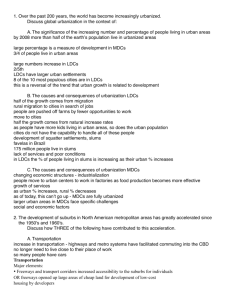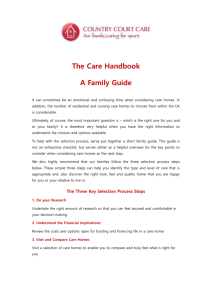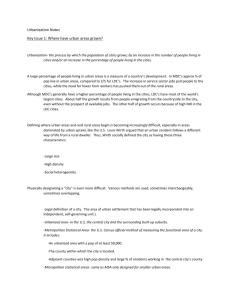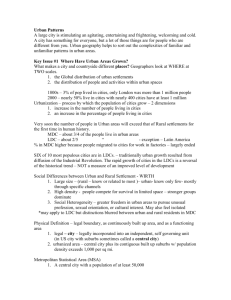Chapter 13: Urban Patterns
advertisement
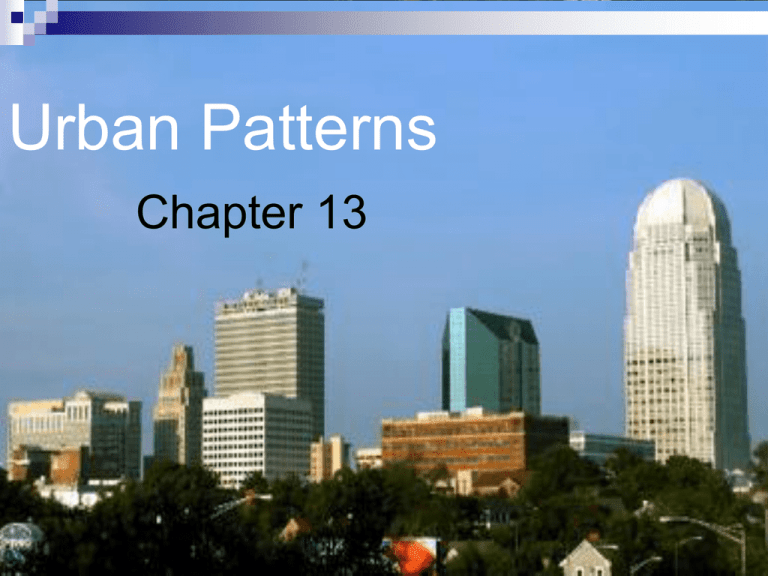
Urban Patterns Chapter 13 Urbanization Def.- the process by which the pop. of cities grows Made up of 2 factors 1. An increase in the # of people living in cities 2. An increase in the % of people living in cities 2 factors occur for diff. reasons and have diff. global distributions continued In 1800, only 3% of World pop. lived in cities and Beijing was the only city with more than 1 million Today ½ of pop. lives in cities and more than 400 cities have at least 1 million people Increasing Percentage of People in Cities 3% in 1800 6% in 1850 14% in 1900 30% in 1950 47% in 2000 2008 urban % surpassed rural for first time in human history continued In MDCs, ¾ live in cities In LDCs, 2/5 live in cities Exception is in Latin America—closely resembles pattern of MDCs Higher % in MDCs due to industrial revolution in 19th Century and growth of service industries in the 20th continued In MDCs the need for fewer farm workers has pushed people to cities to find work Lure of factory jobs and now service jobs has pulled them into urban areas Led to increase in % of people living in urban areas and a decrease in % of people living in rural areas—Duh! Continued Process of urbanization in MDCs began around 1800 and has pretty much ended The % living in urban area can’t increase much more People who wanted to do it already have MDCs are considered fully urbanized continued In LDCs the % has risen rapidly in recent years People come looking for manufacturing or service jobs due to declining farming opportunities Urban jobs are not assured in LDCs to those who migrate—stage 2 Demographic transition model— very high population growth 10 largest cities in the World According to your text BuenosAires, Aires,Argentina Argentina Buenos Delhi, India Dhaka, Bangladesh Jakarta, Indonesia Kolkata, India Mexico City, Mexico Mumbai, India New York City, United States Sao Paulo, Brazil Tokyo, Japan Increasing # of People in Cities 8 of 10 largest cities are in LDCs NY and Tokyo are the only exceptions In 1900, 6 would have been in Europe and three in the US continued Rapid growth of cities in LDCs not because of industrialization or an improved level of development ½ comes from migration for countryside for job opportunities that may not even exist ½ comes from high natural increase rates In African cities, natural increase accounts for 3/4 Defining Urban Settlements Not an easy thing today Top ten lists vary depending on the publication because of differing definitions of the word urban 2 important factors in distinguishing between urban and rural—social factors and physical factors Social Differences Between Urban and Rural Louis Wirth 1930s Different way of life for urban dwellers Defined city as a permanent settlement with 3 characteristics 1. 2. 3. Large size High pop. density Socially heterogeneous people Large size People know only a small % of pop. People have specific roles and most people you do know is according to those roles Ex. I’m your teacher Leads to a different set of social relationships High Density Leads to specialization Each person in urban area has a specified role that allows the complex urban structure to function smoothly Leads to competition of limited resources for survival Social Heterogeneity Larger the settlement, the greater the variety of people More freedom to pursue “different” things Unusual jobs, homosexuality, cultural interests More accepted in large urban areas Despite freedom, many feel lonely or isolated in urban settlements Surrounded by indifferent people Wirth Definition Today Really only applies to LDCs Everyone in MDCs lives urban lifestyles Urban jobs, cars, telephones, TV are available to all in MDCs Physical Definitions of Urban Settlements Used to be easy—cities were walled Today there are 3 ways to physically define an urban settlement By legal boundary 2. As a continuously built-up area 3. As a functional area 1. Legal Definition of a City City- an urban settlement that has been legally incorporated into an independent, self-governing unit Has locally elected officials, ability to raise taxes, and provides certain services to residents Boundaries of city are the limit to the local gov. authority In the US, a city surrounded by suburbs is often called a central city Urbanized Area In the US, the central city and surrounding suburbs are called an urbanized area Pop. Density must exceed 1000 per sq. mile 70% of US residents live in an urbanized area 30% in central cities and 40% in suburbs Difficult to work with this definition, because few statistics are available for them Metropolitan Statistical Area Used because it more fully reflects the influence of an urban settlement beyond its legal boundaries Watching TV stations, reading newspapers, supporting sports teams, etc. Created by US Census Bureau to measure functional area of a city continued 1. 2. 3. Metropolitan Statistical areas include the following: An urbanized area with pop. of at least 50,000 The county within which the city is located Adjacent counties with high pop. Density and a large % of residents working in the central city’s county continued 362 MSAs in the US in 2003—83% of pop. MSAs are not perfect analysis tools Also include extensive land area that isn’t urban continued Micropolitan statistical area- an urbanized area of b/w 10,000 and 50,000 residents, the county in which it is found, and adjacent counties tied to the city 560 in 2003—10% of pop Mostly in area of South and West that used to be rural Overlapping Metropolitan Areas Sometimes MSAs overlap A county in between might send large # of residents to work in both areas In the NE US, MSAs are so close together they now form one continuous urban complex Called Megalopolis– Boston to DC Some call Boswash or Bosnywash continued Other continuous urban complex exist as well Between Chicago and Milwaukee to Pittsburgh Los Angeles to Tijuana Three Models of Urban Structure Created to help explain where different types of people tend to live in an urban area All three were created using Chicago as the model Concentric Zone Model 2. Sector Model 3. Multiple Nuclei Model 1. Concentric Zone Model Created 1923– Sociologist E. W. Burgess Def.- a model of the internal structure of cities in which social groups are spatially arranged in a series of rings continued 1. 5 zones CBD – central business district 2. Innermost ring- concentration of non-residential activities Zone in Transition Industry and poorer-quality housing Often subdivided apartment houses Often filled by immigrants continued 3. Zone of Working Class Homes 4. Zone of Middle Class Homes 5. Modest older houses occupied by stable families Newer and more spacious homes Commuter’s Zone Area of people who don’t live in city where they work Concentric Zone Model- Burgess Sector Model Created in 1939 by economist Homer Hoyt Def. – a model of internal structure of cities in which social groups are arranged around a series of sectors, or wedges, radiating out from the CBD Certain areas of cities are more attractive for various activities Due to chance or environmental factors originally continued As city grows, activities spread outward in wedges/sectors from the center Once a high rent housing district is established, the more expensive new housing grows on the outer edge of that sector Best housing found in a corridor extending from downtown to outer edge of city Industrial and retail activities develop in other sectors—usually along good transportation lines Sector Model - Hoyt Multiple Nuclei Model Created in 1945 by geographers C. D. Harris and E. L. Ullman Def.- a model of internal structure of cities in which social groups are arranged around a collection of nodes of activities Cities are complex and include more than one center around which activities revolve Ex. Ports, neighborhood business centers, universities, airports, parks continued Some activities are attracted to particular nodes, whereas others try to avoid them Bookstores and pizza joints tend to cluster around Universities Hotels and warehouses around airports High-class housing rarely in same neighborhood as manufacturing Multiple Nuclei Model Harris and Ullman Geographic Applications of the Models Help understand where people w/ diff. social char. tend to live in an urban area Explain why certain people tend to live in particular places Effective use of models relies on data at neighborhood levels continued In the US, the data comes form the census Census tracts- an area delineated by the US Census Bureau for which statistics are published; in urbanized areas they roughly correspond to neighborhoods Contain about 5000 people Includes info. on things such as number of nonwhites, median family income, and % of adults with high school diploma continued Spatial distribution of this data can be plotted on a map Called social area analysis Separately, none of the models can completely explain why diff. types of people live in distinctive parts of a city Critics say models are too simple and are too old to represent contemporary urban life continued When combined they help geographers explain where different types of people live in a city People tend to reside in certain locations depending on their particular personal characteristics Most people prefer to live near others with similar characteristics Use of Models Outside of North America Models don’t work as well elsewhere Social groups in other countries may have diff. reasons for selecting their particular neighborhoods European Cities Like the US, wealthier people in Europe cluster along a sector extending out from the CBD In contrast to US, wealthy Europeans live in the inner rings of the upper-class sector—not just in the suburbs Provides access to regions best shops, restaurants, and cultural facilities continued Wealthy Europeans live in townhouses and apartments—no private yards Rely on parks for open space Many purchase abandoned farm buildings in rural settlements for weekend homes away from the city continued Low-income people usually live in large high-rise apartments in the suburbs today Used to live in inner cities with the wealthy before the invention of electricity Vertical social segregation Poor lived in basements and upper floors, while wealthy lived on main levels Today the poor have long commutes by public transportation Suburbs are centers fro crime, violence, and drug dealing continued European Gov.’s encourage high-density suburbs to avoid the sprawl that has occurred in America Less Developed Countries Poor also concentrated in suburbs, wealthy closer to city center Similarity to Europe is not coincidental Colonization continued 1. 2. 3. Most cities in LDCs have had three stages of development Pre colonization Colonial Period Since Independence Pre-colonial Cities Few cities existed in Latin America, Africa, and Asia before European colonization Cities were often laid out surrounding a religious core Ex. Mosque Center would also include a bazaar and wealthy homes Narrow winding streets would lead to lower status neighborhoods far from the core—recent immigrants would live on the edge continued Commercial activities were arranged in a concentric and hierarchical pattern The more important the activity the closer it would be to the religious center Read about the Aztecs and Tenochtitlan on page 443 Colonial Cities Europeans expanded existing cities to provide services such as administration, military command, international trade, and housing for Europeans Sometimes existing city was demolished (Saigon/Ho Chi Minh City was built after demolishing the old city) Sometimes the new city was built next to the old, as in the case of New Delhi continued European cities generally had wider streets and public squares, larger houses surrounded by gardens, and much lower density Colonial cities had standard plans The Laws of the Indies—Spanish plan that outlined how cities would be built in Latin America Cities Since Independence Cities have become the focal points of change since independence Millions have migrated in search of work In Latin American cities wealthy people live in a well-defined elite sector that pushes out from the center Has services such as water, electricity and access to restaurants, theaters, parks, and zoos Squatter Settlements LDCs are unable to house the rapidly growing # of poor who migrate to cities Squatter settlements- an area within a city in a LDC in which people illegally establish residences on land they do not own or rent and erect homemade structures Called India many things- often barrios in LA, bustees in continued UN estimated that 175 million people worldwide lived in squatter settlements in 2003 AN INCREASE OF 75 MILLION SINCE 2000 Have few services, water comes from a truck or central well, no schools, paved roads, telephones or sewers Electricity might be stolen from the nearest power line No bus service or cars—resident must walk to work if employed 33% in Sao Paulo, 85% in Addis Ababa, Ethiopia Inner-City Physical Problems Major problem is poor condition of the housing- most built prior to 1940 Can be demolished and rebuilt or rehabilitated Process of Deterioration As # of low income residents increase in cities, the territory they occupy expands Filtering- a process of change in the use of a house, from single family owner occupancy to abandonment Once wealthy dwellings have been subdivided for lower income residents Once the maintenance costs of the home, become more expensive than the rent collected the houses are often abandoned continued When the homes are abandoned, the schools and shops associated with the neighborhoods close with the declining population Redlining- a process by which banks draw lines on a map and refuse to lend money to purchase or improve property within the boundaries makes it diff. to fix-up deteriorating homes Highly illegal for banks, but difficult for gov. to enforce Urban Renewal Def.- program in which cities identify blighted inner-city neighborhoods, acquire the properties from private owners, relocate the residents and businesses, clear the site, build new roads and utilities, and turn the land over to private developers continued Substandard housing demolished and replaced with public housing Housing owned by the gov; rented low-income residents in the US, rent set as 30% of residents’ income Built by federal gov, and managed by local gov. Less than 2% of all homes in US, but a high % of housing in inner-city neighborhoods continued Most of the “projects” built in the 1950s and 1960s were high-rise apartment buildings Now considered terrible environments for kids Broken elevator, drug use and dealing, and crime are major problems Some argue that high-rises put too many lowincome residents into a high density environment continued Many high rise projects have been torn down in recent years Newer public-housing projects consists of 2 or 3 story apartment buildings or row houses Some cities spread projects throughout the city to avoid heavy concentrations of lowincome residents continued US gov. no longer supports public housing # of units diminished by 1 million b/w 1980 and 2000, while # of households who need it has increased by 2 million Many blame urban renewal for reducing the supply Often called “negro removal” in 1960s because most of those displaced were African American Renovated Housing An alternative to demolishing deteriorated housing is to renovate them These homes usually attract middle-class people Gentrification- a process of converting an urban neighborhood from a predominately low-income renter-occupied area to a predominately middle-class owner-occupied area Attracted by ornate architectural details of older homes or to proximity of downtown Appeals to those with no children—not concerned about quality of schools continued Gentrification is altering ethnic patterns in some cities Ex. Chicago White pop. Is increasing in inner-city neighborhoods Inner-City Social Problems Besides gentrified neighborhoods innercities are increasingly home to a permanent underclass A group in society prevented from participating in the material benefits of a more developed society because of a variety of social and economic characteristics High rates of unemployment, alcoholism, drug addiction, illiteracy, juvenile delinquency, and crime continued Neighborhoods lack adequate police and fire protection, shops, and hospitals Residents lack technical skills necessary for most jobs Less than half complete high school High paying jobs don’t exist for uneducated anymore And low status jobs are increasingly in the suburbs continued Many of the underclass are homeless Estimated 1 million in the US on any given night Perhaps 3 million throughout course of a year 1/3 are mentally ill ¼ children Culture of Poverty 2/3 of babies in inner-cities are born to unwed mothers Mothers must choose to work for income or stay home to care for child Drug usage is high in inner cities Leads to an increase in crime Drug $ or drug related Inner-city Economic Problems Residents require public services but can pay very little of the taxes required to run them Cities often have to reduce services like libraries, public-transit routes, less frequent trash pick-up, etc. Other alternative is to raise tax revenues Tends to drive out wealthier residents and industries Annexation Def.- the process of legally adding land area to a city Peripheral residents no longer want to be annexed Would rather organize their own services than pay city taxes The Peripheral Model Almost 90% of people prefer suburban life Single family homes, private land, parking spaces are all seen as perks Families with children esp. like suburbs North American urban areas follow the peripheral model Says that urban areas consist of an inner city surrounded by large suburban residential and business areas tied together by a beltway continued Peripheral areas lack many of the problems facing inner-city neighborhoods But causes the problems of sprawl and segregation Edge cities- a large node of office and retail activities on the edge of an urban area Originated to service those living in suburbs but evolved into specialized nodes of their own Density Gradient Def.- the changes in density in an urban area from the center to the periphery # of house per unit of land diminishes the further from the city center you travel Changes in Density Gradient 1. 2. Two changes have affected the density gradient in recent years # of people living in city center has decreased-causing a gap in the center An increase in density of the suburbs as apartment complexes have increasingly been built Cost of Suburban Sprawl Sprawl- the progressive spread of development over the landscape Developers seek cheap land to build new housing developments Land is often not contiguous with the existing builtup area Sprawl also spurred by desire some families to won large amounts of land continued Sprawl is expensive Roads and utilities have to be extended into new housing areas—covered by taxes Wastes land—some farmland may be lost Many European countries try to fight sprawl Greenbelts- a ring of land maintained as parks, agriculture, or other types of open space to limit sprawl of an urban area Read pages 454 - 460 Information will be on your test about public transportation and local government fragmentation
